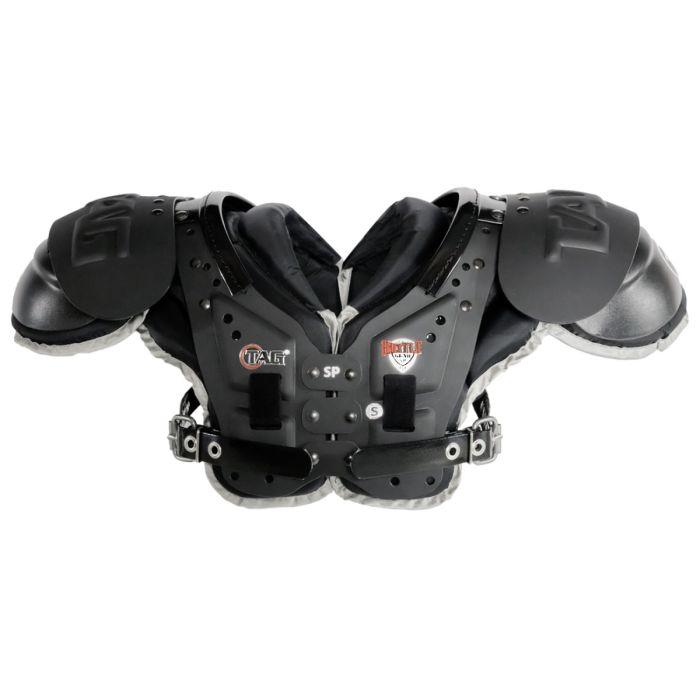Why Lightweight Skill Position Shoulder Pads Are Essential for Wide Receivers and Defensive Backs

In football, each position requires its own style of play, and proper gear can be the difference between performance and safety. Among the most vital equipment are skill position shoulder pads, which are specifically made for players who depend on speed, agility, and specific movement. For wide receivers and defensive backs, lightweight pads are the ideal combination of protection and agility, allowing them to thrive in high-energy situations on the field.
The Requirements of Wide Receivers and Defensive Backs
While linemen have constant heavy contact or linebackers absorbing hard hits, wide receivers and defensive backs excel in open-field play. Their success hinges on:
Speed: Wide receivers need to run off the line of scrimmage and outrun defenders in order to establish separation. Defensive backs have to match this speed to effectively cover them.
Agility: Rapid cuts, backpedals, and quick changes in direction are ongoing demands.
Endurance: These individuals tend to work large areas of the field over the course of the game.
Explosiveness: Jumping up for contested catches or batting passes away from defenders needs bursts of strength.
Due to these particular demands, their gear needs to balance light construction with not cutting back on protection. These are specifically created for this balance.
Why Lightweight Skill Position Shoulder Pads Are Essential
1. Optimal Speed and Agility
Each pound of gear contributes weight that can hinder a player. Wide receivers and defensive backs can't spare lumbering equipment. Skill position lightweight shoulder pads minimize drag, enabling players to quickly accelerate and turn without constraint.
The National Strength and Conditioning Association study points out the way even modest reductions in load can improve sprint performance and agility critical measurements for these positions.
2. Enhanced Range of Motion
To catch a pass with the arms fully extended or defend a deep ball, there has to be unfettered movement of the arm. Shoulder pads designed for linemen may add bulk but restrict range. Skill-position designs emphasize low-profile constructions, which allow greater range of motion for hand fighting, tackling, and receiving.
3. Greater Comfort During Extended Games
Football matches take hours, with plays stretching hours in all kinds of weather. Heavy padding causes fatigue, sweating, and overheating. The most comfortable shoulder pads are those made with breathable fabric and ergonomic cuts that allow players to stay comfortable during four quarters.
4. Protection Without the Bulk
Although agility and mobility are high on the list, safety is still paramount. Newer shoulder pads contain shock-absorbing foam and light plastics that have great impact resistance. This keeps the athlete safe from hard hits while not adding unnecessary weight.
5. Psychological Confidence
Players who believe in their gear play better. Wearing equipment that feels custom-fit, protective, and unrestricted allows wide receivers and defensive backs to feel free to concentrate on play execution instead of misery.
Characteristics That Identify the Top Shoulder Pads for Skill Positions
In order to determine the top shoulder pads for skill positions, athletes and coaches should consider:
Low-profile design: Thin pads minimize bulk and maximize speed.
Strategic placement of padding: Additional cushioning in the shoulders and chest that is not in the way.
Ventilation systems: Ventilation channels and mesh panels that enhance airflow.
Durability: Heavy-duty materials that can handle repeated impacts and hold up for several seasons.
Secure strapping system: Adjustable straps that fit tightly, eliminating pad movement on explosive plays.
Wide Receivers: Why They Need Skill Position Shoulder Pads
Wide receivers are usually in the line of the toughest hits in football, particularly when jumping for a ball in the middle of the field. Meanwhile, they have to remain quick and elusive.
Catch radius enhancement: Light pads enable receivers to reach out fully for passes.
Less fatigue: Less weight maintains energy for end-game sprints.
Freedom for hand combat: With less limitation, receivers have the ability to ward off press coverage.
Reduced fatigue: Minimal weight maintains energy for late-game runs.
For these purposes, these shoulder pads are a complete necessity for the optimal performance and protection at wide receiver.
Defensive Backs: Why They Need Skill Position Shoulder Pads
Defensive backs, cornerbacks, and safeties need both speed and durability. They are tasked with covering quick receivers while also being primary deep pass defenders.
Backpedaling and transitions: Light pads allow for smooth movements in coverage.
Quick reaction tackles: Streamlined pads permit defensive backs to wrap up ball carriers without encumbrance.
Ball-hawking capability: Full range of motion is needed to intercept passes at full extension.
Wearing best shoulder pads for skill positions permits defensive backs to remain agile and combative without compromising required protection.
Data-Driven Insights: Why Lightweight Pads Improve Performance
Sports science research is focused on the connection between the weight of equipment and athletic performance. For the Journal of Applied Biomechanics, decreasing upper-body gear weight enhances sprint acceleration by as much as 2–3%, a considerable share in football where fractions of a second determine plays.
Combined with strength training and conditioning, lightweight skill position shoulder pads enable players to sustain maximum speed and reaction times, providing an advantage over heavier competitors.
Selecting the most effective Shoulder Pads for Skill Positions
In making the best shoulder pads available for skill positions, coaches and athletes must do the following:
Fit over brand: Secure, close-fitting rather than a loud brand name.
Think about playing style: Deep-throwing receivers can opt for ultra-light pads, but tough safeties might prefer a bit more cushioning.
Practice mobility: Players must test their ability to catch, backpedal, and twist while wearing the pads prior to making a selection.
Verify safety certifications: Confirm the pads adhere to National Operating Committee on Standards for Athletic Equipment (NOCSAE) standards.
Balance protection and weight: Opt for the lightest possible pads that can still offer consistent impact protection.
The Future of Skill Position Shoulder Pads
Sports technology innovations are breaking ground when it comes to protective equipment. Technologies like 3D-printed padding, moisture-wicking materials, and intelligent impact sensors are being explored to develop safer and lighter equipment.
For wide receivers and defensive backs, the revolution in skill position shoulder pads translates to even greater effectiveness guarding athletes while allowing for quicker, more dynamic action.
Conclusion: The Essential Edge
Wide receivers and defensive backs exist in the glare of big plays, making highlight-reel receptions and game-saving interceptions. To excel, they require pads that can meet their athletic needs. Lightweight skill position shoulder pads deliver this balance, integrating protection, mobility, and comfort in a package unmatched by any other pads.
In picking equipment, picking the most superior shoulder pads for skill players isn't so much a matter of personal preference; it's about optimizing performance, safety, and confidence. For those who live on speed and quickness, these pads aren't so much necessary as they are game-breakers.






